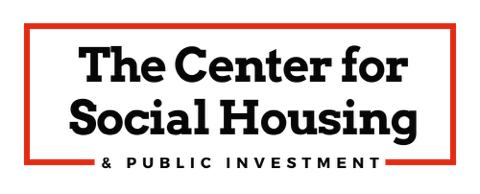Part 4: Social Housing in the United States- An Idea Whose Time has Come
“Local Governments struggling with profit-gouging developers should analyze the situation and consider the viability of doing it themselves- obtaining a sustainable asset and putting developers on notice that the administration will cut them out in the future… This is a long-term reward: a local administration can never be held hostage by developers expecting an unreasonable profit margin again. Even if local authorities do not wish to end their public-private housing partnership schemes at this minute, developing a publicly owned alternative affords them greater autonomy and bargaining power in future procurement decisions; and it does not require them to release large amounts of public land which they cannot easily recover.” – Social Housing in the United States, The People’s Policy Project.
The concept of social housing is gaining traction across the United States. Along with the Bill proposed by Council member Lewis-George in Washington DC, there is also proposed social housing legislation in Maryland as well as California. The California Social Housing Act, proposes to create a public sector housing developer to build publicly owned mixed-income housing that is self-sustaining and revenue neutral. The California bill has a broad range of supporters including labor and local housing advocates. In Maryland, State Delegate Vaughn Stewart has proposed the Social Housing Act, Stewart’s legislation would set up a social housing system influenced heavily by the Vienna model and financed by deed and recordation fees and a tax increase on high-dollar real estate transactions.
The Housing Opportunities Commission
While these legislative proposals are working their way through various state and local governments, maybe the most concrete groundwork for social housing is being laid in Montgomery County, Maryland via their Housing Authority known as the Housing Opportunities Commission of Montgomery County (HOC). As reported by Vox, HOC has shown the power of the Government to be able to develop highly efficient ways to produce publicly owned/mixed-income housing developments.
The HOC model starts with the modest commitment from Montgomery County to appropriate $3.4 million annually over a 20-year period and the HOC then leverages that public money to create a revolving fund to finance the building of mixed-income deeply affordable housing. Again, according to recent reporting from Vox, HOC is on track to build 9,000 units in a short period of time. When describing its model, Vox quoted Zachary Marks, HOC’s chief real estate officer as saying, “What I like about what we are doing is all we have done is commandeered the American real estate model. We are replacing the investor dudes from Wall Street, the big money from Dallas.” Recently, HOC delivered 268 units of affordable mixed-income housing.
Implementation of Social Housing in Washington DC
The District could implement social housing as the foundation of a broader progressive economic development policy. The goal of this policy would be to produce publicly owned mixed-income and sustainable affordable housing while creating jobs and investing resources into District residents and their communities. If DC were to act now, it could put itself on a path to be a leader in showing how alternative development models can transform municipalities by investing in both affordable housing and strong public institutions that lay the groundwork for healthy communities. Below are both immediate and future steps that could be taken to allow for successful implementation.
Land for Future Social Housing Developments
Publicly owned land is arguably the District’s most valuable resource when contemplating the future development of social housing in Washington DC. Land in DC is scarce and extremely expensive. To leverage this resource, the District could begin now to identify the public land it currently owns and start the planning process to develop that land into social housing. This planning can begin immediately, so that once established, the newly created Office of Social Housing can hit the ground running. To this end, it is important that the current public land and the properties owned by the District are not disposed of through the surplus/disposition process until the District has a coordinated social housing policy in place. Until then, land could be banked or placed into community land trusts. As part of a coordinated social housing development strategy, the District could also create a revenue stream for the acquisition of privately-owned land/properties.
Soft Urban Renewal
In neighborhoods that have traditionally been starved of both public and private investment, the District could begin to implement community development policies that center social housing and are in line with the Viennese concept of “soft urban renewal”. Again, this implementation could begin immediately with District officials holding community meetings to explain the concept of social housing while also hearing from the community about their needs/wants beyond housing.
Armed with this information, the District could start to plan for the injection of resources into these communities with a focus on anti-displacement and investment in social projects designed to build long term community stability. This could include an investment in schools, teachers, after school programs, parks, open spaces, sports/art facilities, affordable/free child-care, job programs, small business investment, etc.
Production/Financing
Since 2015 Mayor Bowser has invested $1.4 billion in DC money into the Housing Production Trust Fund (HTPF), which is DC’s primary tool for financing affordable housing development. The fiscal year 2023 budget calls for the investment of an additional $450 million set aside for this fund. Moving forward, HPTF funds could be earmarked principally to leverage the creation of municipally-owned social housing.
To develop the most efficient and productive ways to finance the production of social housing, DC officials could begin meeting with and coordinating their production strategies with neighboring HOC. Simply put, HOC has shown that its model is self-sustainable and much more efficient than the way the District is currently producing housing. As such, the District could adopt a financing model that creates a revolving housing production fund like the HOC model and also explore ways to broaden production and deepen affordability targets through additional tools like the HPTF. Production can be further financed through additional dedicated revenue streams and by accessing federal money for production/rehabilitation and creating green infrastructure. Ongoing operating costs could be funded through a combination of rents and voucher subsidies.
Benefits in Addition to Housing: Efficiency/Jobs/Environmental Impacts
In addition to producing deeply affordable mixed income housing, social housing could be a massive infrastructure project to create jobs, rehabilitate housing that is currently unsafe and make the production of new housing stock environmentally-friendly and efficient. As such, the District could start partnering with anchor institutions such as the University of the District of Columbia, high schools and trade unions to train underemployed and unemployed community members for new jobs in the construction and maintenance of social housing.
The District could also begin to establish labor standards and union buy-in for these projects. The adoption of social housing would put the District on a path to becoming the most efficient and productive producer of affordable housing in the country. As such, it should be constructed by union workers who take pride and ownership in being a part of what would be a historic program.
Conclusion
The District’s current economic development goals are in direct conflict with the ability to deliver safe and affordable housing at the levels necessary to bring down housing costs. The District must not continue to engage in community revitalization projects that seek to inject investment into neighborhoods by promoting the demolition/elimination of affordable housing and displacing working-class residents. This type of development policy drives speculation which increases the cost of land and ultimately drives up rents. These development policies have also produced massive income inequality and created dense pockets of poverty and segregation in Washington DC.
Social housing presents a clear alternative that would produce sustainable and deeply affordable mixed-income housing. Moreover, this model has a track record both internationally and domestically as being much more efficient than the way rental housing is currently being produced. The vast resources of the District could allow it to scale social housing in a way that would make an immediate impact in the lives of District residents and begin to drive down housing costs. In this way, social housing would be an investment not only in housing but in the residents of the District.
Part 1: The Role of Global Finance as a Driving Force in DC’s Affordable Housing Crisis
Part 2: The Economics of Speculation, Demolition and Displacement; A Worsening of Washington DC’s Affordable Housing Crisis
Part 3: The Economics of Housing As a Human Right; How Social Housing Can Solve The Affordable Housing Crisis by Using Public Resources for the Common Good
Part 4: Social Housing in the United States- An Idea Whose Time has Come




